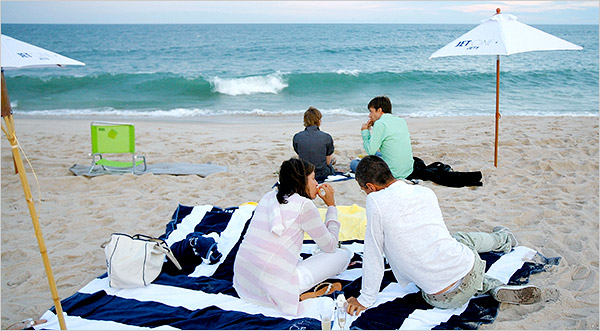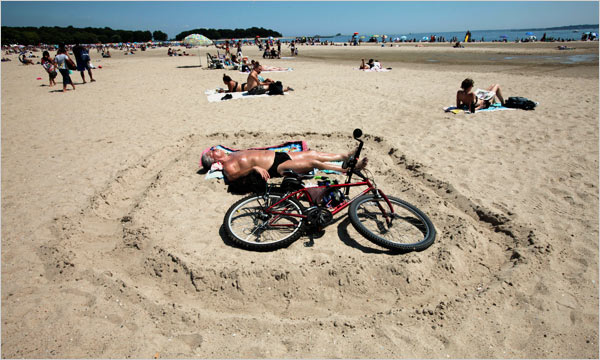One of the attractions of the beach is that so many distinctions seem to melt away into the broad expanses of sun, sea, and sand. Nature offers the same three elements to whoever is there, and there seems to be room enough for everyone, and–for the day, anyway–what more does anyone really need? But, of course, even when life’s a beach, it is a life lived one way rather than another. This image from the Hamptons is one example of what I mean.

I had to stare at this image initially to make sure that it was a photograph. The pictorial values are evocative of the seaside reveries that were a favorite subject for painters around 1900. (For one example having a tone similar to this scene, see Calm Morning (1904) by Frank Weston Benson.) But if life is following art at the Hamptons, the closer source might be a J. Crew catalog. The causal wealth on display here reflects that narrow niche of class and ethnicity, starting with the gorgeous blue and white beach towels. The rest of the scene is more subdued, but the pattern continues: her pink and white shirt, the white breaker of the emerald wave, white umbrellas on orange or yellow poles, the green chair between sand and sea foam. Somehow this world is both colorful and very white.
The blue and white towels create a space of privileged intimacy within the scene, one mirrored by the second couple as well. One member of each pair is eating and listening, savoring, as if there is no hurry, no need to worry about running out of time or anything else. We see them from behind, while standing at a respectful distance, as if servants waiting to be summoned. The photo depicts a summer idyll and also the image of an ideal life, but only for the few.
It should not be surprising that people of wealth can seem so at home in an image that appears to be an oil painting. The photographer’s achievement has been to capture a representative moment in a social stratum by evoking the appropriate pictorial tone from another art and time, albeit while also channeling the commercial iconography that defines that way of life the present. There is more than one beach, however, and more than one way to use a camera.

The caption in the Times (the source for both photos) read, “An early arrival at Orchard Beach in the Bronx staked out his territory on Saturday. Estimates put the crowd at 59,000 by 5 p.m.” I think this shot is hilarious. It might as well be Rodney Dangerfield taking a break from Caddyshack. The guy is a scandal according to the social and aesthetic values of the other photo: damn near naked, exposed to the world, but not before drawing a line in the sand that serves as a big “Keep Out” sign. He looks like a beached whale with attitude, and instead of being huddled in luxury he’s stripped the day down to its essentials: bike, just enough clothing to be decent, a towel just big enough for his body, and a poor man’s moat to keep the 59,000 other people out of his face.
This slice of life on the other side of the cabana is presented courtesy of another photographic perspective. Instead of the faux intimacy of the painting, we have a documentary angle, seeing the subject from the side and set in context, as if a subject for sociological study. And yet the distance is still respectful, allowing him the sovereignty of his temporary kingdom. Unlike the Hamptons photograph, there is no implicit invitation via the fashion code to wish–or buy–our way into the scene.
One photo is from the beginning of summer and the other comes much closer to the end, but that is the least of their differences. The question, however, is not which is the better way of life. I’m not sure there even need be a question. May you find your beach in what little summer remains.
Photographs by Jemal Countess/WireImage and Suzanne DeChillo/The New York Times.
Discussion